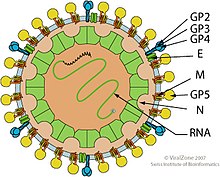| Arteriviridae | |
|---|---|

| |
| Arterivirus virion | |

| |
| Equine artevirus genome | |
| Virus classification | |
| (unranked): | Virus |
| Realm: | Riboviria |
| Kingdom: | Orthornavirae |
| Phylum: | Pisuviricota |
| Class: | Pisoniviricetes |
| Order: | Nidovirales |
| Suborder: | Arnidovirineae |
| Family: | Arteriviridae |
Arteriviridae is a family of enveloped, positive-strand RNA viruses in the order Nidovirales which infect vertebrates.[1][2] Host organisms include equids, pigs, Possums, nonhuman primates, and rodents. The family includes, for example, equine arteritis virus in horses which causes mild-to-severe respiratory disease and reproductive failure, porcine reproductive and respiratory syndrome virus type 1 and type 2 in pigs which causes a similar disease, simian hemorrhagic fever virus which causes a highly lethal fever, lactate dehydrogenase–elevating virus which affects mice, and wobbly possum disease virus.[3][4]
Structure[edit]
Member viruses are enveloped, spherical, and 45–60 nm in diameter.[5]
Genome[edit]
Arteriviruses have a positive-sense single-stranded RNA genome.[5]
Taxonomy[edit]

The family Arteriviridae contains the subfamilies:[6]
- Crocarterivirinae
- Equarterivirinae
- Heroarterivirinae
- Simarterivirinae
- Variarterivirinae
- Zealarterivirinae
References[edit]
- ^ "Arteriviridae ~ ViralZone". viralzone.expasy.org. Retrieved 17 June 2021.
- ^ "Virus Taxonomy: 2018b Release". International Committee on Taxonomy of Viruses (ICTV). March 2019. Retrieved 23 September 2019.
- ^ Dastjerdi, Akbar; Inglese, Nadia; Partridge, Tim; Karuna, Siva; Everest, David J.; Frossard, Jean-Pierre; Dagleish, Mark P.; Stidworthy, Mark F. (February 2021). "Novel Arterivirus Associated with Outbreak of Fatal Encephalitis in European Hedgehogs, England, 2019". Emerg Infect Dis. 27 (2): 578–581. doi:10.3201/eid2702.201962. PMC 7853545. PMID 33496231.
- ^ Kappes, MA; Faaberg, KS (May 2015). "PRRSV structure, replication and recombination: Origin of phenotype and genotype diversity". Virology. 479–480: 475–86. doi:10.1016/j.virol.2015.02.012. PMC 7111637. PMID 25759097.
- ^ a b "Chapter 25 - Arteriviridae and Roniviridae". Fenner's Veterinary Virology (Fifth ed.). Academic Press. 2017. pp. 463–476. doi:10.1016/B978-0-12-800946-8.00025-8. ISBN 9780128009468. S2CID 216045035.
- ^ "Taxonomy". International Committee on Taxonomy of Viruses. Retrieved 25 March 2020.
External links[edit]
 Media related to Arteriviridae at Wikimedia Commons
Media related to Arteriviridae at Wikimedia Commons
Well, that’s interesting to know that Psilotum nudum are known as whisk ferns. Psilotum nudum is the commoner species of the two. While the P. flaccidum is a rare species and is found in the tropical islands. Both the species are usually epiphytic in habit and grow upon tree ferns. These species may also be terrestrial and grow in humus or in the crevices of the rocks.
View the detailed Guide of Psilotum nudum: Detailed Study Of Psilotum Nudum (Whisk Fern), Classification, Anatomy, Reproduction